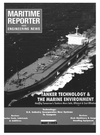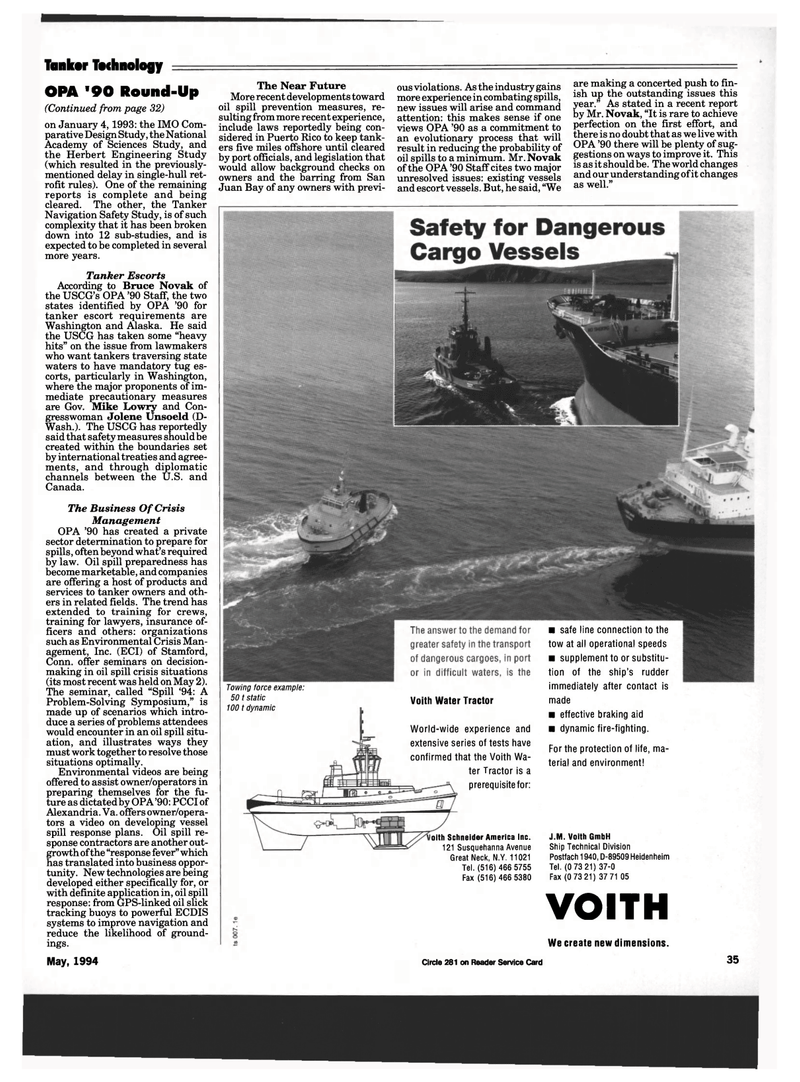
Page 33: of Maritime Reporter Magazine (May 1994)
Read this page in Pdf, Flash or Html5 edition of May 1994 Maritime Reporter Magazine
Tanker Technology
OPA '90 Round-Up (Continued, from page 32) on January 4, 1993: the IMO Com- parative Design Study, the National
Academy of Sciences Study, and the Herbert Engineering Study (which resulted in the previously- mentioned delay in single-hull ret- rofit rules). One of the remaining reports is complete and being cleared. The other, the Tanker
Navigation Safety Study, is of such complexity that it has been broken down into 12 sub-studies, and is expected to be completed in several more years.
Tanker Escorts
According to Bruce Novak of the USCG's OPA '90 Staff, the two states identified by OPA '90 for tanker escort requirements are
Washington and Alaska. He said the USCG has taken some "heavy hits" on the issue from lawmakers who want tankers traversing state waters to have mandatory tug es- corts, particularly in Washington, where the major proponents of im- mediate precautionary measures are Gov. Mike Lowry and Con- gresswoman Jolene Unsoeld (D-
Wash.). The USCG has reportedly said that safety measures should be created within the boundaries set by international treaties and agree- ments, and through diplomatic channels between the U.S. and
Canada.
The Business Of Crisis
Management
OPA '90 has created a private sector determination to prepare for spills, often beyond what's required by law. Oil spill preparedness has become marketable, and companies are offering a host of products and services to tanker owners and oth- ers in related fields. The trend has extended to training for crews, training for lawyers, insurance of- ficers and others: organizations such as Environmental Crisis Man- agement, Inc. (ECI) of Stamford,
Conn, offer seminars on decision- making in oil spill crisis situations (its most recent was held on May 2).
The seminar, called "Spill '94: A
Problem-Solving Symposium," is made up of scenarios which intro- duce a series of problems attendees would encounter in an oil spill situ- ation, and illustrates ways they must work together to resolve those situations optimally.
Environmental videos are being offered to assist owner/operators in preparing themselves for the fu- ture as dictated by OPA '90: PCCI of
Alexandria. Va. offers owner/opera- tors a video on developing vessel spill response plans. Oil spill re- sponse contractors are another out- growth of the "response fever" which has translated into business oppor- tunity. New technologies are being developed either specifically for, or with definite application in, oil spill response: from GPS-linked oil slick tracking buoys to powerful ECDIS systems to improve navigation and reduce the likelihood of ground- ings.
May, 1994
The Near Future
More recent developments toward oil spill prevention measures, re- sulting from more recent experience, include laws reportedly being con- sidered in Puerto Rico to keep tank- ers five miles offshore until cleared by port officials, and legislation that would allow background checks on owners and the barring from San
Juan Bay of any owners with previ- ous violations. As the industry gains more experience in combating spills, new issues will arise and command attention: this makes sense if one views OPA '90 as a commitment to an evolutionary process that will result in reducing the probability of oil spills to a minimum. Mr. Novak of the OPA '90 Staff cites two major unresolved issues: existing vessels and escort vessels. But, he said, "We are making a concerted push to fin- ish up the outstanding issues this year." As stated in a recent report by Mr. Novak, "It is rare to achieve perfection on the first effort, and there is no doubt that as we live with
OPA '90 there will be plenty of sug- gestions on ways to improve it. This is as it should be. The world changes and our understanding of it changes as well."
Towing force example: 50 t static 100 t dynamic
Voith Water Tractor
World-wide experience and extensive series of tests have confirmed that the Voith Wa- ter Tractor is a prerequisite for: oith Schneider America Inc. 121 Susquehanna Avenue
Great Neck, N.Y. 11021
Tel. (516) 466 5755
Fax (516) 466 5380 • safe line connection to the tow at all operational speeds • supplement to or substitu- tion of the ship's rudder immediately after contact is made • effective braking aid • dynamic fire-fighting.
For the protection of life, ma- terial and environment!
J.M. Voith GmbH
Ship Technical Division
Postfach 1940, D-89509 Heidenheim
Tel. (0 73 21) 37-0
Fax (0 73 21) 37 71 05
VOITH
We create new dimensions.
Circle 281 on Reader Service Card 35

 32
32

 34
34
